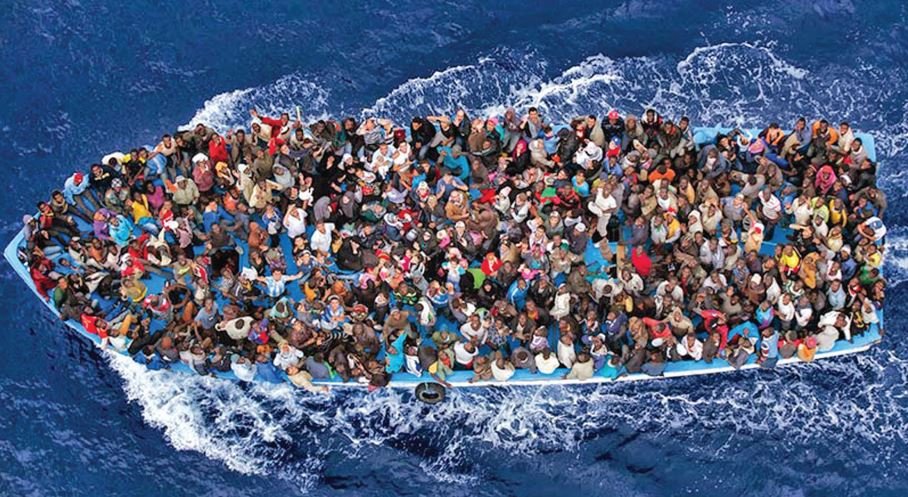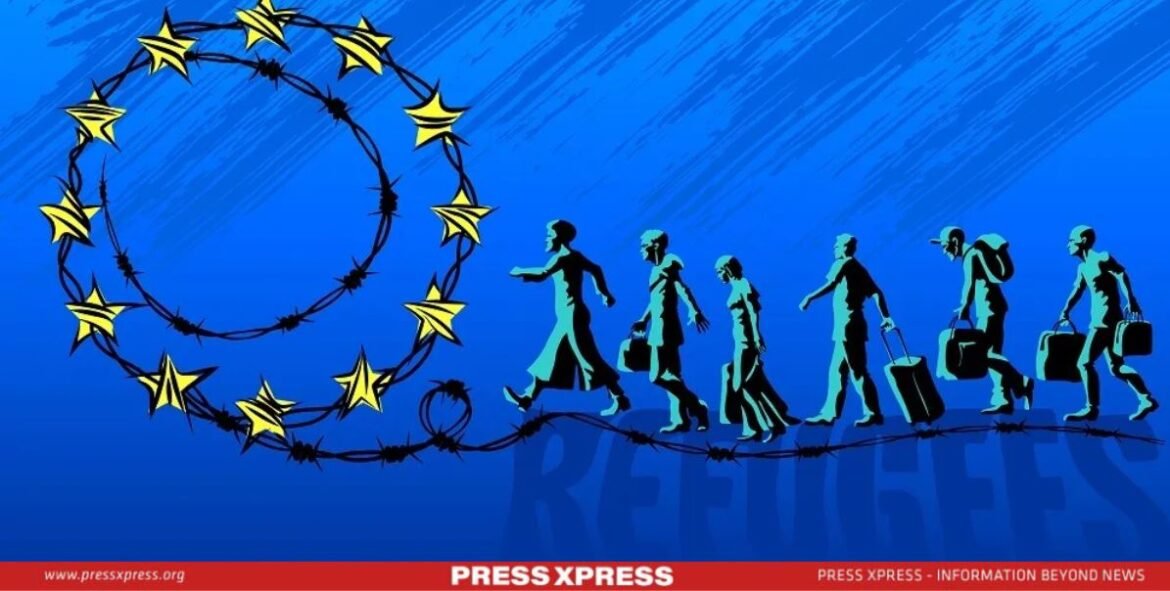The year 2023 marked a pivotal moment for the European Union (EU) as it grappled with an unprecedented influx of refugees, surpassing a staggering one million individuals. Amid this surge, the Moria refugee camp on the Greek island of Lesbos emerged as a haunting emblem of the EU’s faltering refugee policy. Designed to accommodate a modest 2,800 souls, it instead harbored up to 20,000 men, women, and children, dwelling amidst deplorable sanitation and health crises.
Migration expert Franck Düvell from the University of Osnabrück highlighted the dire need to prevent intolerable conditions for refugees during the ‘Global Refugee Report’ presentation in Berlin. Despite various efforts, many camps still fail to meet basic refugee protection standards.
The ‘Global Refugee Report’, a joint effort by scholars from the Universities of Erlangen-Nuremberg and Osnabrück, the International Center for Conflict Studies in Bonn, and the German Institute of Development and Sustainability (IDOS) analyzes the impact of the updated Common European Asylum System (CEAS). Under the new framework, asylum seekers may face up to 12 weeks in reception centers at the EU’s borders before their petitions are processed.
During this period, they will stay in communal facilities designed to house up to 30,000 people. Expedited border procedures will apply to those from countries with low asylum acceptance rates, including families with children. Petra Bendel from the University of Erlangen-Nuremberg expressed serious concerns about the welfare of vulnerable minors and families under this stringent approach.
CEAS Reform Risks Prolonged Displacement in Host Countries
In 2023, European leaders signed a notable agreement with Tunisia, providing over €100 million for ‘border management’ and nearly €1 billion to support Tunisia’s struggling economy. However, in July, reports surfaced of Tunisian security forces rounding up hundreds of Europe-bound refugees and abandoning them at the desert border with Libya without food, water, or shelter.

Düvell cautioned that such deals with authoritarian regimes threaten democratization efforts in these nations. “Europe is making itself highly dependent on despots,” he warned.
Germany has welcomed around 1 million Ukrainian refugees, with the government praised for avoiding centralized accommodation and relying heavily on civil society’s support. While researchers commended the EU’s flexible response, they warned that the temporary residence status for Ukrainian refugees, ending in 2025, requires urgent action to prevent future crises.
The researchers highlighted that the EU’s strategies could adversely affect poorer countries hosting far more refugees than Europe. The CEAS reform is expected to prolong displacement situations outside Europe, drawing parallels to the Rohingya in Bangladesh and Syrians in Turkey, situations are ‘largely ignored’ in Germany.
Developments in the Middle East also raised alarms among the researchers, particularly after the October 7, 2023, Hamas attack on Israel and Israel’s subsequent actions in Gaza. The displaced in Gaza are effectively trapped, unable to flee. Benjamin Etzold from the Bonn International Center for Conflict Studies described the Palestinians’ plight in Gaza as a ‘worst-case scenario’.
Etzold emphasized the need for the EU and German governments to enhance their commitment to improving global refugee conditions, criticizing the current focus on limiting access to Europe and urging a more compassionate and comprehensive approach to the worldwide refugee crisis.
Migration Pact Sparks Debate Over Its Narrow Focus
On April 10, 2024, the European Parliament narrowly approved the Pact on Migration and Asylum with a vote of 300 in favor and 270 against. This pact aims to overhaul the EU’s fragmented asylum system, which has faced persistent challenges since the 2015 refugee crisis. From extensive consultations since 2020, the Commission’s proposal addresses the ongoing discord among Member States and the uneven burden of irregular migration.
Despite its extensive name, the EU’s Pact on Migration and Asylum exclusively addresses asylum seekers, overlooking broader migration issues like labor shortages and aging populations. This limited scope has disappointed NGOs and various political factions within the EU.
Final negotiations for the pact occurred amidst heightened irregular migration post-pandemic, exacerbated by the influx of 4 million Ukrainian refugees in 2022. With 300,000 and 380,000 irregular arrivals in 2022 and 2023 respectively, EU asylum systems became overwhelmed, leading to a backlog of about a million asylum seekers by 2023. This surge in migration, coupled with political tensions, particularly at the Polish-Belarusian border and Ceuta, resulted in increased support for restrictive asylum policies among Member States like Germany, Sweden, and France.

Context of Final Negotiations
- Influx of Ukrainian Refugees: 4 million in 2022
- Irregular Arrivals: 300,000 (2022) and 380,000 (2023)
- Backlog: About a million asylum seekers by 2023
The Pact on reflects a shared goal of controlling arrivals, criticized for its restrictive stance, potentially leading to higher rejection rates at the border. While aiming to standardize procedures and reduce friction between Member States, the pact imposes stricter processes.
A major challenge lies in the ineffective repatriation of failed asylum seekers, with only 20% successfully returned due to weak agreements. Efforts to combat human trafficking face structural challenges, and initiatives like ‘Talent Partnerships’ are beneficial but insufficient to meet migration demands.
Potential Failure of EU’s Migration Pact Could Lead to Harsher Immigration Policies
Implementation of the pact requires substantial funding for new facilities and procedures, with the EU expecting to collect €600 million annually from Member States opting to pay €20,000 per non-admitted asylum seeker. Provisions for ‘crisis’ situations, where migration is weaponized for political purposes, are included, as seen in recent events in Poland, Lithuania, and Ceuta.
The Pact, slated for implementation in June 2026, faces challenges in ensuring Member States’ readiness to build border infrastructure and adopt new administrative procedures. Germany, the largest asylum recipient, grapples with internal tensions, driven by overwhelmed refugee systems and rising far-right electoral support, prompting calls for externalizing asylum processes.
Opposition to the pact from Hungary, Poland, and Denmark, set to hold the EU Council presidency, casts doubt on its full enactment by 2026. The likelihood of a more hardline European Parliament post-election further adds to political pressure against the pact. NGOs anticipate legal battles, particularly against the pact’s ‘non-entry’ provisions and border procedure quality of legal aid.
Rising instability in Africa, the Middle East, and Eastern Europe suggests a surge in migration towards the EU, heightening political tensions within and between Member States.
Without significant progress in relations with origin countries to improve deportation rates, the pact’s structures will fail to curb irregular immigration. If the pact cannot be applied effectively, Member States may adopt even harsher immigration policies, further threatening the freedom of movement within the Schengen area and increasing reliance on non-EU countries for asylum processing.
Such outcomes would not only exacerbate migration issues but also highlight the EU’s political fragility and its difficulty in coordinating responses to common challenges.


